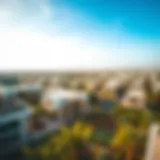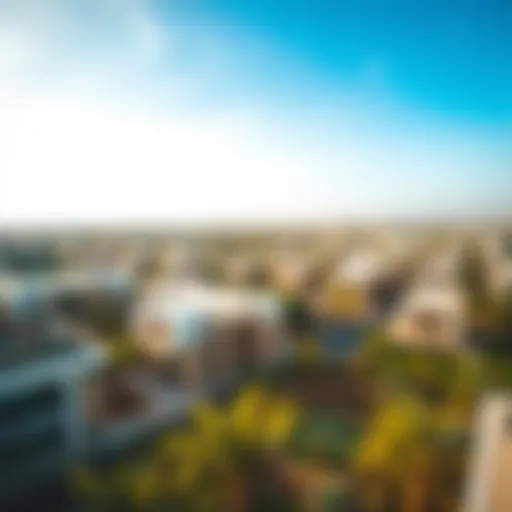The Flamingo Building: Architectural Marvel in Dubai


Intro
The Flamingo Building stands as a striking representation of modern architecture amidst the evolving skyline of Dubai. Its unique design and operational features not only serve its functionality but also contribute to the cultural fabric of the region. As more architectural innovations emerge in Dubai, the Flamingo Building becomes a focal point for discussions around urban design and sustainability.
Emerging from a fusion of cutting-edge technology and artistic vision, this building underscores the soaring ambitions of a city that is not just a hub for tourism and commerce, but a leader in global architecture. The aim of this exploration is to delve into the architectural significance of the Flamingo Building, assessing its design, spatial characteristics, and broader impact on the Dubai real estate market.
Market Trends in Dubai Real Estate
Current Market Overview
Dubai’s real estate landscape is as dynamic as its architectural achievements. With ongoing developments and migrations of a multicultural population, the real estate sector embodies a blend of luxury living and business attractions. The Flamingo Building, with its remarkable design, has become an emblem of this evolution, attracting not only lifestyle seekers but also investors who recognize its potential.
The market has exhibited a resilience against global economic fluctuations, buoyed by government initiatives and infrastructural advancements. Data suggests that the demand for properties in Dubai has shifted towards trendy areas like Dubai Marina and Downtown, where iconic buildings, including Flamingo, are situated.
Price Trends and Forecasts
In recent years, property prices have shown fluctuations, reflecting shifts in supply and demand, along with various policy changes. There has been a noticeable increase in interest from both local and international investors, particularly post-pandemic, as the market starts to recover.
"Dubai's property market is experiencing a renaissance, driven by favourable regulatory reforms and sustained demand for innovative structures."
Potential investors should keep an eye on market forecasts, as experts suggest a steady upward trend over the next few years. Notably, areas that house landmark buildings like the Flamingo could witness above-average appreciation, influenced by their prestige and connectivity.
Investment Opportunities
Hot Areas for Investment
With the world’s gaze set on Dubai, investment opportunities have become plentiful. The signage on real estate investments in areas surrounding the Flamingo Building, such as Al Khail Road and Business Bay, is becoming increasingly enticing. Investors are looking for prime real estate that offers not just aesthetic value but also functional benefits and robust returns.
- Dubai Marina: Known for its luxurious apartments and vibrant lifestyle.
- Downtown Dubai: Home to iconic spots like the Burj Khalifa, it promises high rental yields.
- Business Bay: A leader in commercial and residential developments, also notable for its accessibility and amenities.
Rental Yield Analysis
Potential rental yields in Dubai vary, but properties near the Flamingo Building are currently leading. Investors are reaping benefits from an increasing influx of expatriates and tourists seeking short-term accommodation options.
Typical rental yields can range from 6% to 10%, with premium properties in this vicinity often exceeding these figures. Factors influencing these returns include:
- Proximity to major hubs: Easy access to business districts and leisure spaces boosts rental attractiveness.
- Quality of amenities: Higher service standards often command higher rental prices.
- Market demand: Continuous relocation trends influence the short-term and long-term rental markets.
Preface to the Flamingo Building
The Flamingo Building stands as a testament to Dubai's relentless pursuit of innovation and architectural excellence. It's not just another structure in a city bursting at the seams with advanced designs; it symbolizes the merging of luxury with function, tradition with modernity. For investors, homebuyers, and real estate agents, understanding this architectural marvel is crucial for grasping the wider narrative of Dubai's evolving skyline. The Flamingo Building isn’t just a pretty face; it carries with it a rich tapestry of cultural significance, urban development considerations, and investment potential.
Overview of the Structure
The Flamingo Building is characterized by its unique silhouette, which seems to leap from the landscape in vibrant pink and orange hues, drawing inspiration from the birds that grace the nearby waters of the Gulf. This isn't merely aesthetic; the design was carefully curated to maximize visibility and offer stunning views from its upper floors. With a height of approximately 200 meters, it is recognized not only for its vivid colors but also for its distinct biomimicry-inspired architecture.
Each floor is thoughtfully designed, facilitating natural light flow and ensuring that ventilation is optimized. The building's facade is a combination of glass and sustainable materials, marrying both beauty and purpose. The choice of materials allows it to shimmer during the day while glowing at night, creating a beacon that attracts residents and tourists alike. Visitors often describe the Flamingo Building as akin to a lighthouse amidst the urban forest, standing tall and inviting amidst the hustle and bustle of Dubai.
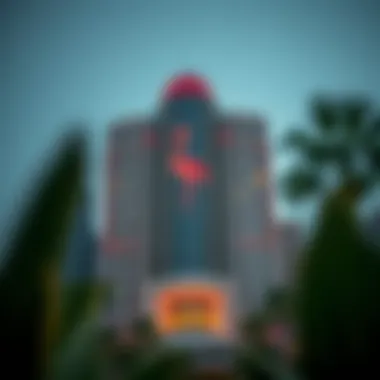

Historical Context
To fully appreciate the significance of the Flamingo Building, one must look back at Dubai's rapid growth from a humble fishing village to a global city. The development of such iconic structures represents more than architectural ambitions; it illustrates an era where economic diversification became paramount for the emirate, especially after the oil boom in the late 20th century. The Flamingo Building was conceived during a period of reflective prosperity, intended to embody Dubai’s commitment to innovation and luxury.
As Dubai positioned itself on the global stage, construction became intertwined with the city’s cultural narrative. Architects began to draw inspiration not only from local influences but also from international styles, creating hybrid structures that resonate with global trends. The Flamingo Building stands at this intersection, representing both traditional Arab architecture and cutting-edge modern design. According to city planners, buildings like this contribute significantly to the identity of Dubai, showcasing how the emirate is not afraid to embrace boldness while respecting its cultural roots.
As we explore the architectural and cultural layers of the Flamingo Building in further sections, we will delve more into its structural details and the socio-economic impacts it has had on the surrounding area. Insight into the community initiatives it has fostered will further highlight its relevance in a city that continuously reinvents itself.
Architectural Design Elements
Architectural design elements play a crucial role in defining the identity and utility of any structure. In the case of the Flamingo Building, these elements not only highlight its aesthetic appeal but also enhance its functionality and sustainability. Elements such as materials, shapes, and layouts come together to create a cohesive vision that invites exploration and interaction. This section delves into specific aspects of the Flamingo Building's architectural design, shedding light on their significance and contribution to the building's overall charm and purpose.
Exterior Features
The exterior of the Flamingo Building is nothing short of striking, capturing attention from afar with its bold lines and unique silhouette. Constructed with a mix of glass and steel, the facade is designed to reflect and refract sunlight, creating a visually dynamic surface. This is not merely for show; it also serves a functional purpose by reducing heat gain, contributing to the building's energy efficiency.
- Color Palette: The choice of colors for the exterior reflects the surrounding desert landscape, blending caffeine hues of cream and terracotta with vibrant splashes of coral that echo the bird it’s named after. It’s a subtle nod to nature, which resonates well with locals and tourists alike.
- Structural Innovations: The use of cantilevered balconies allows residents breathtaking views of the Dubai skyline. This innovative approach not only maximizes living space but also adds depth to the design, inviting sunlight and air to circulate.
- Landscaping: Surrounding the building, lush gardens with native plants create a soft contrast to the hard architectural lines. This integration of nature not only promotes biodiversity but also provides a serene environment for residents and visitors.
Interior Layout and Aesthetics
Stepping inside the Flamingo Building, the design narrative shifts to one of elegance and contemporary style. The interior layout is a masterclass in maximizing space while ensuring comfort and functionality.
- Open Floor Plan: A seamless flow between living, dining, and kitchen areas is evident. This design caters to modern lifestyles that value openness and connection among spaces.
- Aesthetic Choices: Warm wood accents are utilized throughout, providing an inviting atmosphere. Coupled with artisanal light fixtures, the interiors feel both stylish and welcoming.
- Natural Light Utilization: Large, floor-to-ceiling windows are strategically placed, allowing natural light to flood the spaces. This features not only reduces the need for artificial lighting but also connects residents with the vibrant outdoor environment.
Innovative Use of Space
The architectural design of the Flamingo Building takes an inventive approach to space utilization, ensuring that no corner is left wasted.
- Flexible Areas: Rooms can easily adapt to different uses—a guest room can turn into a home office as needed. This flexibility is particularly appealing to millennials and young professionals who value multifunctional spaces.
- Social Hubs: Common areas designed for social interaction, such as lounges and rooftop gardens, further encourage community bonding. Spaces like these serve as informal meeting points, enhancing the sense of belonging amongst residents.
- Sustainable Design: Incorporating green roofs and terraces not only optimizes available space but also serves environmental roles, promoting flora and fauna within the urban context. This clever use of available space highlights a thoughtful consideration for the building's impact on the surroundings.
"The Flamingo Building's design epitomizes how architectural innovation can marry elegance with functionality, creating spaces that breathe life into contemporary urban living."
In examining these architectural design elements, it becomes evident that the Flamingo Building is not just another skyscraper in Dubai; it represents a thoughtful dialogue between form and function, aesthetics and sustainability. Whether for investors, homebuyers, or real estate agents, the significance of these design aspects offers considerable depth and insight into the future potential of this remarkable structure.
Sustainability and Environmental Integration
Sustainability has emerged as a cornerstone in modern architecture, especially in sprawling urban landscapes like Dubai. The Flamingo Building represents a significant step towards eco-conscious design, merging aesthetics with environmental responsibilities. Through its commitment to sustainability, the structure not only enhances the urban skyline but also champions the global movement towards more environmentally friendly practices.
Eco-Friendly Materials
When it comes to the Flamingo Building, the choice of materials reflects a strong eco-friendly philosophy. Concrete is a prominent feature in the construction of many towering structures, however, here, it is blended with recycled components. This approach drastically reduces the carbon footprint associated with traditional methods. Moreover, the glass facades are made with high-performance materials that regulate temperature naturally, minimizing the need for excessive heating or cooling indoors. In addition to enhancing aesthetic appeal, these choices ensure that the building operates efficiently, aligning with the sustainability ethos that is increasingly demanded by today’s consumers and investors.
Energy Efficiency Strategies
Energy conservation is another vital aspect that the Flamingo Building showcases comprehensively. The design incorporates various energy-efficient strategies aimed at reducing overall consumption. Firstly, the integration of solar panels on the rooftop allows for the harnessing of natural energy, which significantly cuts down utility costs over time. Smart technology plays a crucial role; the building's systems are fitted with sensors that manage light intensity and temperature, adapting automatically based on the time of day and occupancy levels.
This intelligent design not only reduces energy wastage but also aligns with the increasing awareness of sustainable living among residents and businesses alike. The Flamingo Building shines as a beacon of how modern architecture can fulfill high standards of energy efficiency.
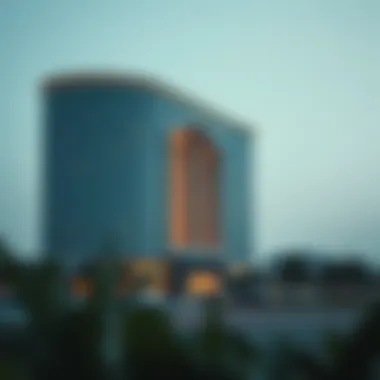

Impact on Local Ecosystem
The Flamingo Building doesn’t merely sit idly in its environment; it actively engages with it. A notable element is the landscaping around the building, which includes native vegetation that thrives in Dubai’s arid climate. This approach conserves water resources, cuts down on maintenance costs, and provides a habitat for local fauna, which can be hard to find in urban centers.
Furthermore, the building's strategic placement within the city embraces natural light and ventilation, thus lessening reliance on artificial sources. This thoughtful integration nurtures the local ecosystem rather than disrupts it, reinforcing the narrative that modern developments can exist harmoniously with nature.
In essence, a commitment to sustainability is not just a trend; it is a necessity for the future of urban living, and the Flamingo Building stands at the forefront of this movement, paving the way for future architectural endeavors in Dubai and beyond.
Cultural and Social Significance
Understanding the cultural and social significance of the Flamingo Building goes beyond mere fascination with its physical architecture. It is a testament to Dubai's commitment to blending modernity with tradition, while also serving as a platform for engagement among diverse communities.
Influences on Local Art and Culture
The Flamingo Building functions as more than a simple structure; it symbolizes a vibrant fusion of artistic expression and cultural dialogue. Artists and creators find inspiration in its innovative design and unique silhouette, leading to collaborations that often transcend conventional boundaries.
- Art Installations: The exterior of the building has served as a canvas for various art installations, some temporary and others more permanent, inviting local artists to showcase their talents. This not only highlights local craftsmanship but also fosters a sense of community pride.
- Cultural Events: Regular events held in and around the building, such as art exhibitions and performances, allow local artists to connect with a broader audience. These moments become cultural touchpoints that resonate with both residents and tourists alike.
Public spaces around the Flamingo Building, designed to promote interaction, encourage community spotlighting, creating a lively atmosphere. Murals, street performers, and pop-up art markets have transformed the surrounding area into a veritable open-air gallery that displays the evolving nature of Dubai’s artistic community.
Community Engagement Initiatives
Community engagement is at the heart of the Flamingo Building's ethos, and several initiatives stand out:
- Local Workshops: The management organizes workshops aimed at teaching skills related to art, design, and sustainability. This allows community members to develop new talents and express themselves creatively, reinforcing the connection between the building and its inhabitants.
- Partnerships with Schools: Collaborating with local educational institutions, the Flamingo Building serves as a learning hub where students can explore architecture, urban planning, and environmental stewardship. Such initiatives foster appreciation for the architectural marvel while stimulating young imagination.
- Social Responsibility Projects: The building is involved in various social responsibility projects aimed at improving community well-being. From tree-planting drives to sustainability fairs, these projects not only beautify the environment but also create avenues for social interaction.
Engaging the community has had a ripple effect, building a sense of belonging that is essential in a rapidly transforming city like Dubai. As different cultural influences mingle, the Flamingo Building stands as a beacon of collective identity.
"Monuments like the Flamingo Building are not just bodies of steel and glass; they are reflections of who we are as a society and where we want to go together."
Market Trends and Investment Potential
In an era where urban landscapes are constantly morphing and evolving, understanding the market trends and investment potential related to the Flamingo Building is pivotal for stakeholders ranging from investors to real estate agents. It’s not just about bricks and mortar, but rather about seizing opportunities in an ever-changing economic climate. This section emphasizes the relevance of market dynamics in shaping investment strategies and community development around this architectural marvel.
Analysis of Real Estate Trends in Dubai
Dubai's real estate market is known for its vibrancy, driven by a blend of local demand and international investment interest. The Flamingo Building, with its iconic design and centrally located position, plays a significant role in these trends. According to market reports, Dubai has experienced fluctuations, but new regulations and incentive programs from the government have positively impacted property values. Specifically, we can note:
- Diverse Buyer Base: Has witnessed an influx of expatriates looking for luxury and comfort, boosting demand.
- Investment-Friendly Atmosphere: The government’s approach to foreign investments, including residency visas tied to property purchases, has stimulated interest.
- Technology Integration: Virtual property tours and blockchain ownership methods are becoming standard, enhancing the buying experience.
These factors collectively shape the overall real estate climate in Dubai and contribute to the Flamingo Building's investment allure.
Opportunities for Investors
Investing in the Flamingo Building isn’t merely a passive venture; it's an active engagement in a marketplace poised for growth. Potential investors can find multiple angles to capitalize, such as:
- Rental Returns: Given its attractive location and features, properties within the Flamingo Building are projected to yield competitive rental income.
- Appreciation Potential: As Dubai solidifies its image as a global hub, property values are expected to rise, making early investments in such projects significantly profitable.
- Commercial Prospects: The building also presents opportunities for businesses looking for space within a fascinating architectural work, increasing foot traffic and visibility.
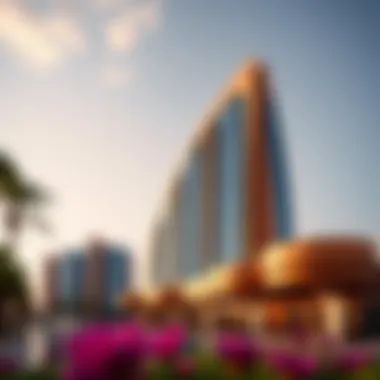

By taking a closer look at these facets, one can understand why this structure is becoming the center of attention for savvy investors.
Future Developments in the Surrounding Area
The future trends around the Flamingo Building suggest a surge in urbanization and infrastructural enhancement. Here are a few key developments that pose exciting prospects:
- Transportation Improvements: The ongoing expansion of the metro and road networks will likely enhance accessibility to the Flamingo Building. New transport links will facilitate easier commutes, which will boost property desirability.
- Cultural Attractions: Upcoming cultural and entertainment venues, such as museums or galleries, are set to enrich the local atmosphere, elevating resident quality of life and attracting more visitors.
- Sustainability Initiatives: Local government investment in green spaces and eco-friendly projects will enhance the appeal of residential and commercial investments here, aligning with global sustainability trends.
Challenges and Controversies
The Flamingo Building stands as a striking testament to modern architecture in Dubai, but with its grandeur come various challenges and controversies that have spurred much debate among professionals and the public alike. Understanding these issues is crucial for anyone involved in the real estate sector or architecture. This section delves into both construction challenges that hindered the development process, as well as ongoing public perception and critiques surrounding the building.
Construction Challenges
Building such an ambitious structure in the heart of a bustling metropolis is no walk in the park. The Flamingo Building faced significant construction challenges, primarily due to its innovative design and the extreme environmental conditions typical of Dubai.
Firstly, the extreme heat in the region posed risks that threatened not just the timeline but the very integrity of the building materials used. Workers contended with such heat that proper hydration and safety measures became paramount. As a result, construction schedules had to be carefully managed, often working during the cooler hours of the day to avoid heat-related issues.
Secondly, the building's unique architecture necessitated specialized materials and techniques that were not readily available in the local market. For instance, the implementation of energy-efficient glass and advanced insulation systems required sourcing from overseas suppliers. This not only added to the costs but also sometimes delayed the progress as shipments and approvals led to unforeseen complications.
"Innovative designs often prolong the completion of a project, but it's the final result that truly counts."
In addition to these logistical hurdles, the site itself posed challenges resembling a jigsaw puzzle. The urban landscape of Dubai is crowded, and finding sufficient space for materials and machinery was never easy. Navigating around existing structures and densely populated areas proved to be a trial of patience and ingenuity.
Ultimately, each of these construction challenges engineered lessons that could benefit future projects, showcasing not just the strength of the architectural vision but also the need for adaptability in execution.
Public Perception and Critiques
While the Flamingo Building dazzles many with its design, public perception has not been uniformly positive. Critics often voice concerns over the building's environmental impact, societal implications, and its overall fit within Dubai's skyline.
One major point of contention is the sustainability of the structure in an already urbanized environment. Activists argue that while the building claims to implement eco-friendly solutions, the true extent of its environmental footprint remains to be seen. Community response has pointed fingers at the construction practices rather than just the architectural wonder itself. Many wonder if the benefits outweigh any potential harm to the local ecology, particularly regarding urban sprawl that could disrupt existing habitats.
Moreover, local art and culture enthusiasts have raised questions regarding the building's lack of traditional aesthetic elements that reflect the rich heritage of Dubai. Some feel it stands as a stark contrast to the old and venerable architecture that defines much of the city's identity.
In essence, while the Flamingo Building is a bold new statement on the Dubai skyline, public reception has been a mixed bag fraught with opinions. For real estate investors and home buyers, the controversies surrounding the building can serve as a benchmark. Understanding community sentiment can inform future investments and highlight areas where cultural preservation may need to coexist with modern innovation.
As the discussions around the Flamingo Building continue, it becomes evident that such challenges and controversies are not just barriers but also opportunities for growth, teaching lessons in construction and community engagement alike.
Closure: The Legacy of the Flamingo Building
The Flamingo Building stands as a pivotal testament to Dubai's architectural aspirations. It does not merely serve as a functional structure; it encapsulates a vision that resonates throughout the skyline. The convergence of innovative design and local cultural elements has crafted a legacy that will endure long into the future. The building has become more than just a physical landmark; it symbolizes a broader narrative about urban development and sustainability in a rapidly evolving metropolis.
Long-Term Impact on Dubai's Skyline
The Flamingo Building introduces an aesthetic that invites new interpretations of luxury and modernity. As it graces the Dubai skyline, it's not just about height or grandeur but about a unique identity among the towering giants. The building's unique facade, with its striking curves and colorful accents, adds an avant-garde touch to the visual landscape of the city. Over time, these characteristics are likely to inspire future projects, pushing architects and developers to think outside the box and prioritize creativity along with functionality.
In the grand scheme of things, it's apparent that the Flamingo Building is poised to influence urban growth patterns, serving as a reference point for forthcoming architectural undertakings. As a result, it attracts attention from both locals and tourists, thus reshaping perceptions of what a modern city should embrace.
"The Flamingo Building is more than just bricks and mortar; it is a beacon of innovation, where architectural dreams meet the realities of city life."
Positioning Within Global Architecture
Globally, the Flamingo Building garners recognition not merely as a regional landmark but as a contender on the world stage. It competes with architectural phenomena in cities like New York and Tokyo, asserting Dubai's position as a hub of avant-garde architecture. The synergy of modern-day techniques with traditional craftsmanship reflects a growing trend where local architectural styles are kept alive while adapting to modern needs.
In an era of globalization, the Flamingo Building stands as an exemplar of how a structure can respect cultural roots while integrating cutting-edge technology. This dual approach places it in conversations about sustainable architecture worldwide, as it addresses both societal and environmental concerns without compromising on elegance. Whether one is an investor eyeing real estate opportunities or an architecture aficionado, the relevance of the Flamingo Building to the global architectural dialogue cannot be overstated. The building is a reminder of the possibilities when creativity melds with practicality, inspiring future generations to strive for excellence in their own urban environments.




